OUR street machine scene is as much about heritage as it is about innovation and the adoption of new ideas, technologies and techniques. So new for this year’s Summernats Elite show was a celebration of our hobby’s foundations with a terrific display of five iconic street machines.
This article was first published in Street Machine’s Summernats magazine, 2014
For many – possibly most – of the Summernats show-goers these five streeters were a gentle diversion from the bling and jingle of the Top 60 show. For others, it was the chance to see these significant street machines for the first time – several of these cars have not been seen in public for more than 20 years – and really get to witness street machining’s past glories and discover where some of today’s influences have come from.
On display celebrating the 80s, 90s and noughties eras of street machining were cars built by Graham Stubbs, Brett Lewis, Colin Townsend and Brian and Janelle Willis. Peter and Michelle Fitzpatrick’s FC Holden was nearby, too. In its three iterations this car has been a significant influence in street machining over the past 15 or 20 years.
We salute you all!
Brett Lewis’s Blue Moon HR Holden
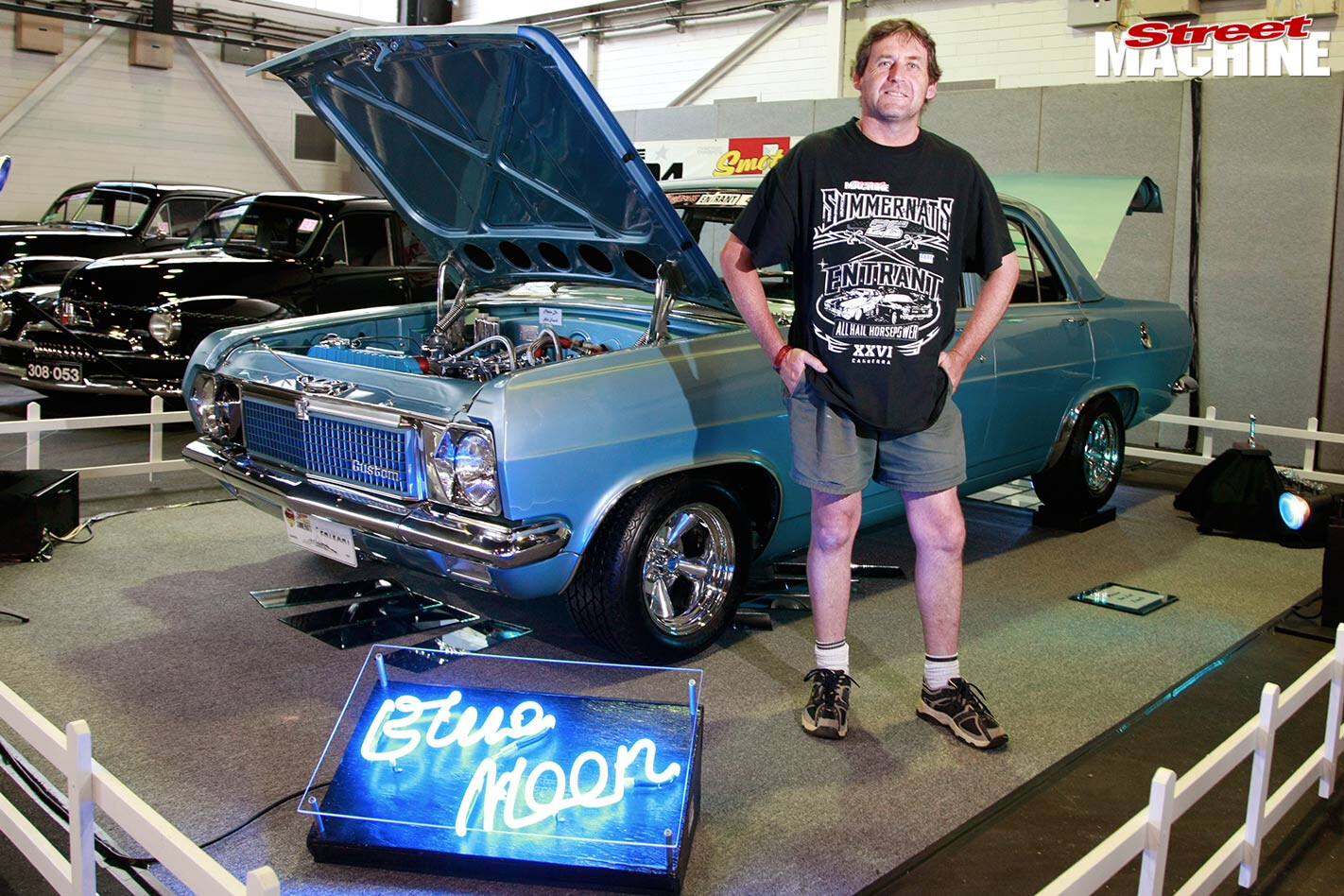
That’s one rightly proud feller, right there! Brett Lewis debuted his classic HR Holden 30 years ago exactly as it is now – right down to the spot lights and neon Blue Moon sign! After 20 years away from the scene, Brett is back with a grin to show present-day street machiners how it was done in the 80s
BRETT Lewis’ HR Holden, Blue Moon, stood proud at Summernats 27. With its 13-inch alloys, plenty of engine bay chrome, triple SU carbies and bucket seats from an era when most cars had benches, the car is a classic 1980s streeter built at home and painted in the driveway. It debuted – complete with its show display stand with glorious Blue Moon neon sign – at the 1984 Street Machine Nationals.
Up front, the sweet HR Prem runs a HZ Holden Kingswood grille with chrome-plated infill panels between the grille edges and the headlights. With the HR’s grille-mounted indicators gone, the lower front panel was back-dated with an HD Holden item, complete with that model’s under-bumper lights. This was a popular bolt-on mod from the era when HDs, HRs and other 60s Holdens and Falcons were a dollar-a-dozen on the streets and in wreckers’ yards.
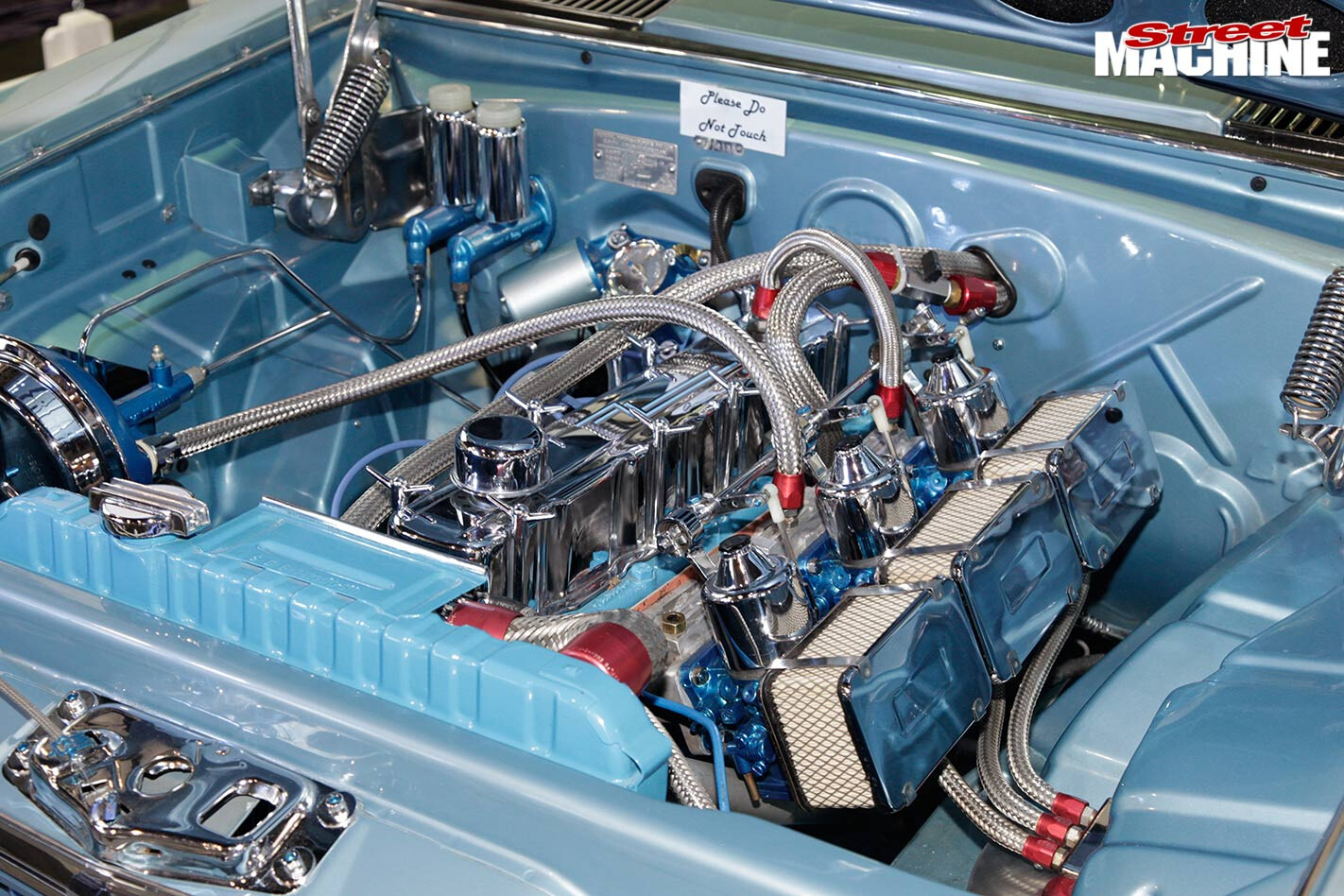
Triple carbies, lots of chrome and braided line – it was a classic formula for hot Holden six success in the 1980s. Thankfully, Brett has resisted the urge to ‘update’ his HR Holden so it’s testament to how things were. Legend!
There are 80s street machine details and knick-knacks everywhere. “I was inspired by Stubbs’s Chev,” says Brett, who had the honour of displaying his HR at Summernats 27 in the same iconic line-up as Malibu Magic. “The toolkit in the boot was something he did!” Thankfully, Brett resisted the temptation to install HQ Holden wagon tail-lights, another popular street machiners’ tweak from the 80s. Instead, he blue-dotted the standard tail-lights, hot-rod style.
The car was damaged by dickheads at Summernats in the early 1990s. “I was so heartbroken, I stored the car for 20 years,” says Brett. In hindsight, cocooning the car for two decades means it has been perfectly preserved, right down to the dickheads’ scratches in the paint! Another worthy icon.
Triple carbies, lots of chrome and braided line – it was a classic formula for hot Holden six success in the 1980s. Thankfully, Brett has resisted the urge to ‘update’ his HR Holden so it’s testament to how things were. Legend!
That’s one rightly proud feller, right there! Brett Lewis debuted his classic HR Holden 30 years ago exactly as it is now – right down to the spot lights and neon Blue Moon sign! After 20 years away from the scene, Brett is back with a grin to show present-day street machiners how it was done in the 80s.
Graham Stubbs’s ’65 Chev Malibu
GRAHAM Stubbs was a pioneer street machiner. “He pretty much wrote the book,” says John McCoy-Lancaster, Graham’s friend and colleague and now custodian of his ’65 Chevelle Malibu streeter, Malibu Magic. “As street machining evolved from the panel van and hot rod scenes, he helped structure things.”
Summernats head judge Owen Webb agrees. “He would be at every show,” says Owen. “He obviously saw how the scene was evolving. At some stage, someone had to take control – he stepped up to the line and said, ‘Hey, we need a proper judging regime here.’”
Malibu Magic is now recognised as Australia’s first – and arguably most successful – street machine built for show. In its 15-year show career from 1979, Malibu Magic won more than 400 trophies, including four-in-a-row Top Street Machine titles from 1985-88.
Against the backdrop of Summernats 27’s Elite stunners, the car appears modest – even simple – but this car was truly advanced for its time, with every aspect of its build and detailing intended to score points.
Even though Malibu Magic was repainted every year to keep it looking pristine, it was driven to every event, with Graham being staunch in his attitude that street machines be street machines.
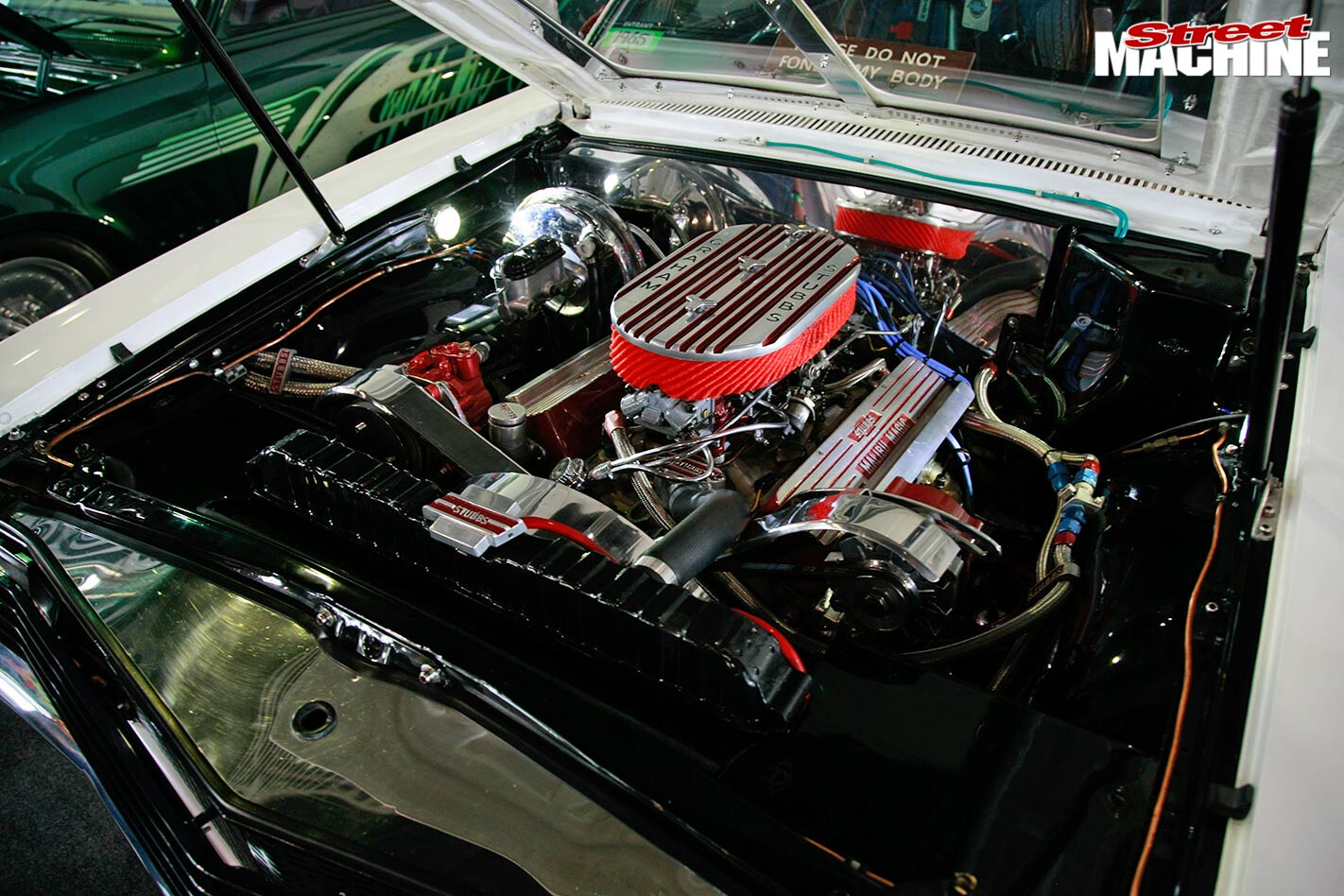
Personalised rocker covers and air cleaner top are just a couple of examples of the myriad of innovations to be found on Maibu Magic
Graham’s poor health led to the car’s retirement around 1993. Bought by John and Donna McCoy-Lancaster after Graham’s passing last year, the car required plenty of attention after sitting for two decades. John and Donna replaced the exhaust and tyres and commissioned AA Panel Craft to rectify the weather-beaten paint. A further 400 hours were spent detailing the car, restoring its appearance to when it was the pinnacle of Australian street machining 30 years ago.
Personalised rocker covers and air cleaner top are just a couple of examples of the myriad of innovations to be found on Maibu Magic.
Mike Duggan’s ’69 HT Monaro
MIKE Duggan’s BILLIT Monaro should be familiar to long-time readers of Street Machine. Built by Bill Murfin, it was featured back in SM, April/May ’97 and also won SMOTY that year. Not long after it was sold to the US and has only recently come back to Australian shores. It’s pretty much unchanged from those glory days and is still in remarkable condition, but Mike figured the engine needed a little updating. “It’s just something I had laying around under the bench that used to be in a BMW drag car. It’s a 542-cube Rodeck block with Brodix heads and a Littlefield 14/71 on top. I had a carbon fibre Big & Ugly hat on it but I changed it to an old style Enderle hat to keep it as old school as I could but got rid of the Hurst Lightning Rods because I thought they dated the car a little bit,” Mike says.
The engine was built by Paul Sant at Pro Flo Performance and freshened up for BILLIT, so you know it’s got as much go as show. The 10.5 Outlaw Nova Mike debuted last year was also built by Paul and he’s planning on getting that on the track by the time you read this.
And rumours that Bill Murfin was at Summernats are unfounded. He was kicking back in Queensland, and although he hasn’t seen the car, he had heard it had been changed and wasn’t entirely convinced it was the right thing to do. “It’s not my car anymore, so it doesn’t really matter, but I don’t like blowers, they’re for trucks that haul heavy loads.”
After doing the show scene for a couple of years back in the late-90s, Bill ran into problems with storing the car and ended up selling it to someone who was heading to the US and wanted a car to drive. It ended up being sold into a private museum and was never seen.
Since then, Bill’s been heavily involved with the Variety Club in Queensland and has built 18 cars to compete in Bash events that raise money for underprivileged kids. He’s about to embark on a new career in project management, and, if the funds ever allow it, his idea of the ideal car is a custom ’41 Willys with an AWD Audi S8 driveline underneath. One thing is certain, Bill Murfin is still thinking outside the box. BV
STREET LEGAL
BUILT by Dave Marsh of the Our Town Van Club, the HJ Holden van dubbed Street Legal won Australia’s Top Van three times between 1988 and 1992 and made the Top 10 at Summernats 5. The van is now owned by Brett Hansford and all the original features remain, including the way-out Star Trek-themed murals, bubble diamond side windows, Trans Am front, blown Holden V8 and, of course, the wild, bordello-style interior, complete with button tufted crushed velour trim, mirrors and mini-TV.
“I’m a bit of a van freak,” says Brett. “I’ve owned a few, including Untamed, Dream Warrior and Wolfman, but when this one came up I knew it was the one.
“This is the first time the van has been back to Summernats in a long time and it got a really good reaction – so many people came up to me and said they remembered it. I’m considering changing the paint, as it is starting to finally show signs of age. And I really don’t like Star Trek. [laughs] I’ll keep everything else just as it was.”
The van was there to help promote The Pambula Motorfest, which is held on the NSW south coast on April 14. If you missed seeing the van at the ’Nats it will be proudly on display at Pambula, so check out pambula-motorfest.com for details. ST
Brian Willis’s HK Monaro
BRIAN and Janelle Willis’ HK Monaro perfectly represents a state-of-the-art street machine from the 1990s. It debuted at Summernats 20 years ago! It also represents the dedication and enthusiasm of a young Aussie street machiner and his wife who not only built this car, but chucked in his job to take the car far and wide to show it.
Some of the biggest names of the era had a hand in the car, most notably Owen Webb who laid on the spectacular paint and graphics. Barry Byrt of Hume Performance built the mild small-block, with Fuellie heads by Ben Gatt chassis work by John Cannon
Thanks to its extremely high level of build quality and the fact the vehicle was set up to drive, Brian and the Monaro won Summernats Grand Champion on its first attempt before Brian Janelle showed it at events in Brisbane, Perth, Tasmania, Melbourne, Mount Gambier and elsewhere, traveling around in an ex-circus transport truck.
The HK’s interior was right on the cutting edge back in the day, nutted out by Stuart Davis
Incredibly, the Monaro went on to earn an Elite Top-10 place at Summernats for the next seven years – has any other street machine achieved this? – until its semi-retirement after Summernats 2000. Brian is now a Summernats judge.
Despite its jaw-dropping appearance, the car was built to a sensible budget using more hard work than hard currency. “I started this car when I was a second-year apprentice,” explains Brian. “It was a bunch of mates working in a garage. When I was building it, Howard [Astill, well-respected Elite car crafter] recommended that nothing be bought for the car. Everything should be crafted. You have to realise, too, this car was built at home in the days before online shopping. It was a lot more difficult back then.
The HK’s relatively mild driveline was a key to its success in grabbing the Grand Champ gong way back when and means it is a turn-key cruiser all these years later
These days this iconic street machine is an occasional cruiser around Brian and Janelle’s home town of Orange, NSW.
Colin Townsend’s FJ Holden
It’s 20 years since Colin Townsend stunned the country with his wild wide-body FJ, but it offers lessons to car crafters today
SIZZLING in its concept, stance and construction, the Colin Townsend-built wide-body FJ Holden is iconic. Now owned by Colin’s good mate Kevin Brown and proudly shown in Canberra for the first time in the Street Machine Icons display in the Elite Hall, most who witnessed this car’s incredible presence and build quality did so for the first time.
Colin’s foundation for the car’s build was function over form. “The fact it’s shiny is just a bonus!” he reckons. The only change Colin would make to the car if he built it today would be EFI and larger wheels. In fact, few gazing at this astonishing FJ realised it was built 20 years ago! We chatted to Colin to get a glance into the philosophy behind one of Australia’s most visionary and innovative street machines.
You built a Pro Tourer before that term became the latest and greatest?
Yes – that’s a comment that’s been made in the past. But it goes back further than that – every car I’ve ever had has been built to this [theme].
For instance…?
There was a 48-215 that I built: turbocharged 186, BorgWarner four-speed, nine-inch, coil-sprung rear end, disc brakes, rack ’n’ pinion. That was on the road in ’79!
These days the Townsend FJ is owned by good mate Kevin Brown. Colin’s dad’s stocker made the trip for comparison purposes
So that was practice for this FJ?
In a way, yes. This one was mapped out in the early 1980s. It took 13 years to build but some of that time was on a previous car that didn’t eventuate. The suspension design and tech ended up in this one.
You really went deep with the suspension and handling tech…
Yes. We measured the flex in the bodyshell with the Y-frames attached and figured out where the movement was so we could design bracing.
And then the suspension?
That’s right. The rear end wasn’t too difficult to work out but the front end was far more involved. We used a computer program; it was leading edge at the time and an updated version is being used in V8 Supercars today. Back then, we weren’t allowed to use fabricated parts [in suspension] so we had to base everything on production stuff. We used a HK Holden crossmember and modified its lower control arms. The spindles are from a 60s Chev and we played with the upper pivot points. Plus, the rack ’n’ pinion.
You make it sound easy!
Ha! Yeah, it always is in hindsight. Everything in the car is a one-off – it’s time, not money. There was no opening up a catalogue and buying billet stuff. Everything is hand-built. There were problems. If it was a Chev I could have bought about 200 manifolds for it, but being a Holden, back in the day there’s wasn’t much available and the one I bought was crook – it didn’t match the heads. It had to be totally reworked.
If the FJ looks like it is about a foot wider than stock, that’s because it is! The guards, doors, bumpers, stone trays and grille were all stretched to suit
Tell us about the engine.
It’s a Holden V8 taken out to 362 cubes. It has Webers and we built it for drivability, but it has plenty of power; around 230kW at the wheels.
And the body is a standout.
Plenty of work in that! The centre section is standard – but with a few tweaks – but each guard was spliced together from about 30 sections. The rear doors… it was a lot of work. A bloke by the name of Mark Linn performed most of that.
You may not have realised it but you were creating a street machine benchmark. It’s timeless.
Yeah, I guess I know that now. I didn’t want to build a car that would date, like something with a pink interior or graphics. If I was to build it today, I’d have bigger diameter wheels to help me with tyre choice, and fuel injection to help with drivability, but with the eight throttle bodies so everything would look the same.
LEGAL8
LIKE the Townsend FJ, Neville Phillips’s LEGAL8 EH (SM, July/Aug ’92) was another groundbreaking car out of Adelaide, pre-empting the Pro Touring movement by a decade or so. Built by Mark Sanders, the EH was designed to be a fully South Oz legal – no easy feat for a V8 early girl in the early-90s. The car packed a tough 308 stroker/Top Loader/9in driveline combo, with a three-link rear end, HQ front discs and a well though-out front end set-up, radically improving the EH’s ability to stop and swerve. And guess what? It still does.
“The EH has almost 40,000 miles on it since we built it,” says Neville, who is on about his sixth or seventh trip to the ’Nats since the car’s heyday. And while the engineering has stayed true to the original vision, the Gunmetal Grey paint has seen a few updates, and with good reason. “We’ve done a fair bit of competition stuff with the EH,” says Neville casually.
“We’ve done Targa Tasmania twice, the Dutton Rally, Targa Adelaide and a season of regularity at Mallala. We had a couple of binges in Targa Tassie. One year we came of the road and a hit a tree, but I was better off than the guy behind me. He missed the tree and sailed off an embankment! Now the car runs custom-made carbon fibre front guards and bonnet.”
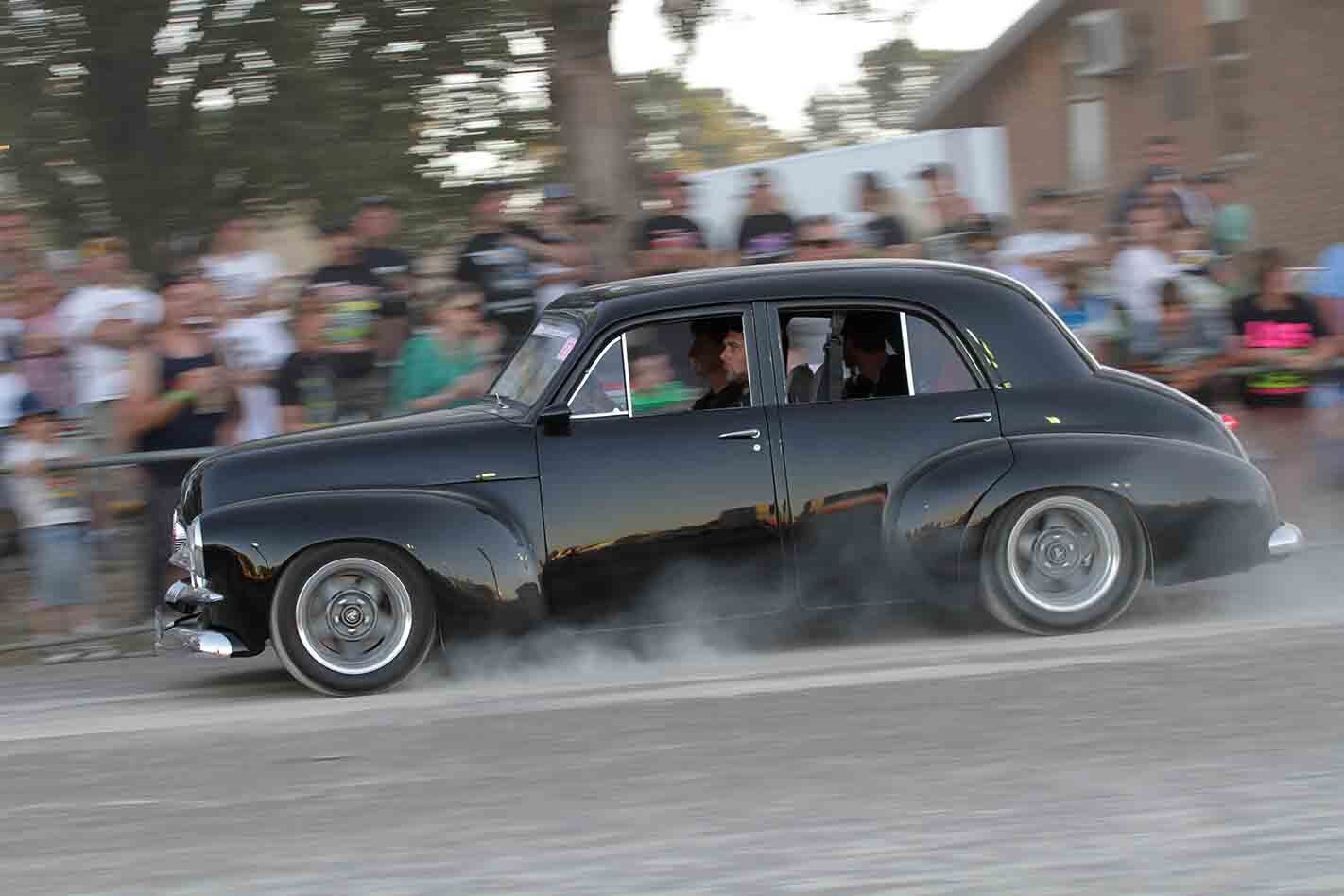
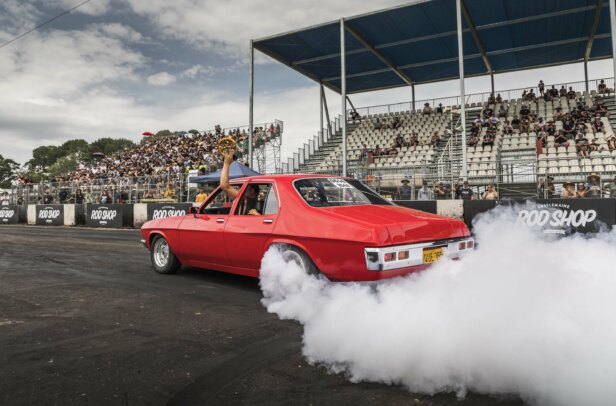
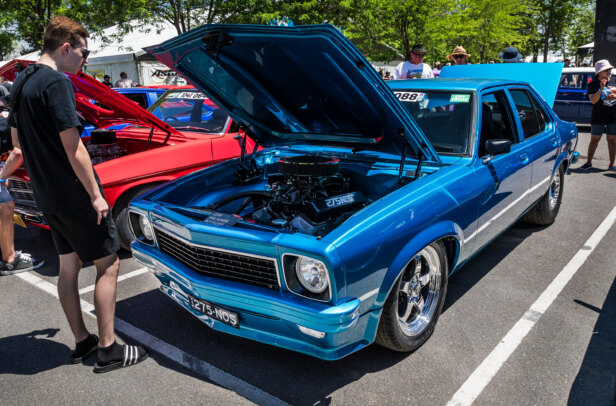
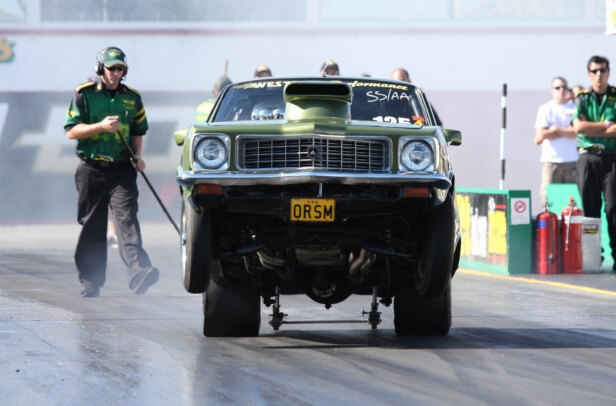
Comments